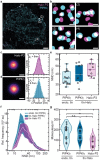Peptide-PAINT Enables Investigation of Endogenous Talin with Molecular Scale Resolution in Cells and Tissues
- PMID: 34286903
- PMCID: PMC8518977
- DOI: 10.1002/cbic.202100301
Peptide-PAINT Enables Investigation of Endogenous Talin with Molecular Scale Resolution in Cells and Tissues
Abstract
Talin is a cell adhesion molecule that is indispensable for the development and function of multicellular organisms. Despite its central role for many cell biological processes, suitable methods to investigate the nanoscale organization of talin in its native environment are missing. Here, we overcome this limitation by combining single-molecule resolved PAINT (points accumulation in nanoscale topography) imaging with the IRIS (image reconstruction by integrating exchangeable single-molecule localization) approach, enabling the quantitative analysis of genetically unmodified talin molecules in cells. We demonstrate that a previously reported peptide can be utilized to specifically label the two major talin isoforms expressed in mammalian tissues with a localization precision of <10 nm. Our experiments show that the methodology performs equally well as state-of-the-art single-molecule localization techniques, and the first applications reveal a thus far undescribed cell adhesion structure in differentiating stem cells. Furthermore, we demonstrate the applicability of this peptide-PAINT technique to mouse tissues paving the way to single-protein imaging of endogenous talin proteins under physiologically relevant conditions.
Keywords: cell adhesion; peptides; protein-protein interactions; single-molecule studies; talin.
© 2021 The Authors. ChemBioChem published by Wiley-VCH GmbH.
Conflict of interest statement
The authors declare no conflict of interest.
Figures




References
-
- Geiger B., Spatz J. P., Bershadsky A. D., Nat. Rev. Mol. Cell Biol. 2009, 10, 21. - PubMed
-
- Kechagia J. Z., Ivaska J., Roca-Cusachs P., Nat. Rev. Mol. Cell Biol. 2019, 20, 457. - PubMed
-
- Critchley D. R., Ann. Rev. Biophys. Bioeng. 2009, 38, 235. - PubMed
-
- Tadokoro S., Shattil S. J., Eto K., Tai V., Liddington R. C., de Pereda J. M., Ginsberg M. H., Calderwood D. A., Science 2003, 302, 103. - PubMed
Publication types
MeSH terms
Substances
Grants and funding
LinkOut - more resources
Full Text Sources
Medical

